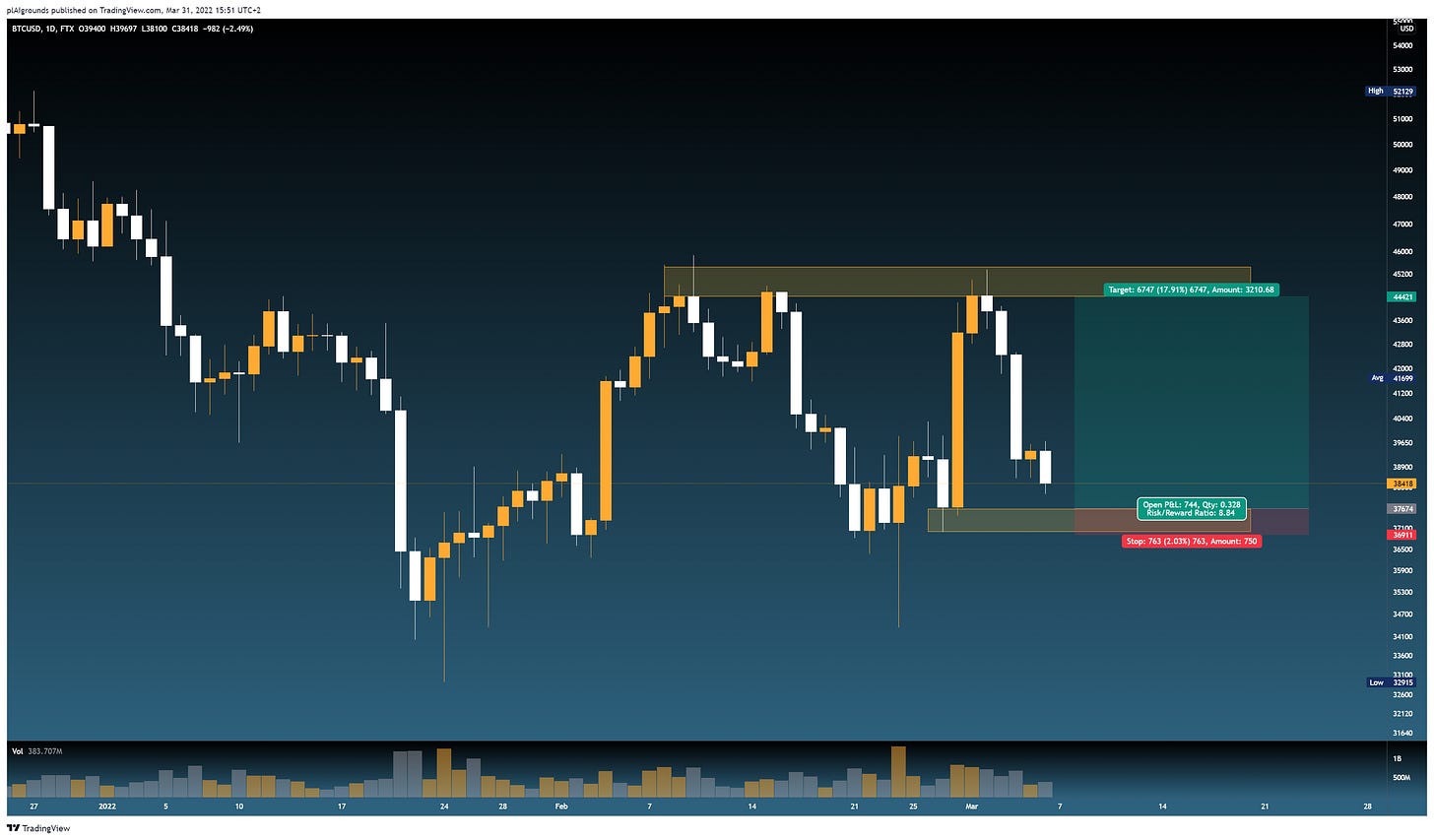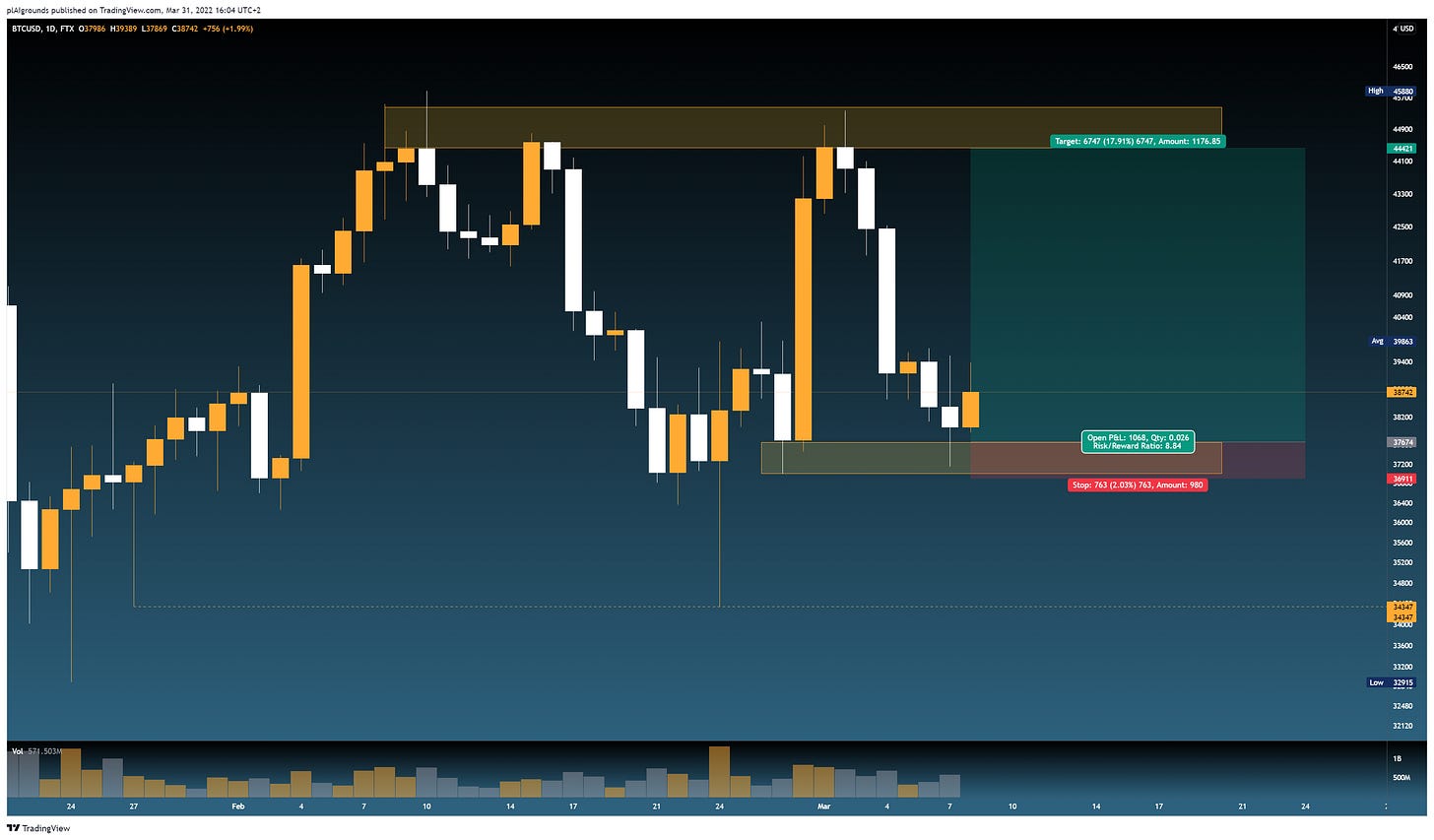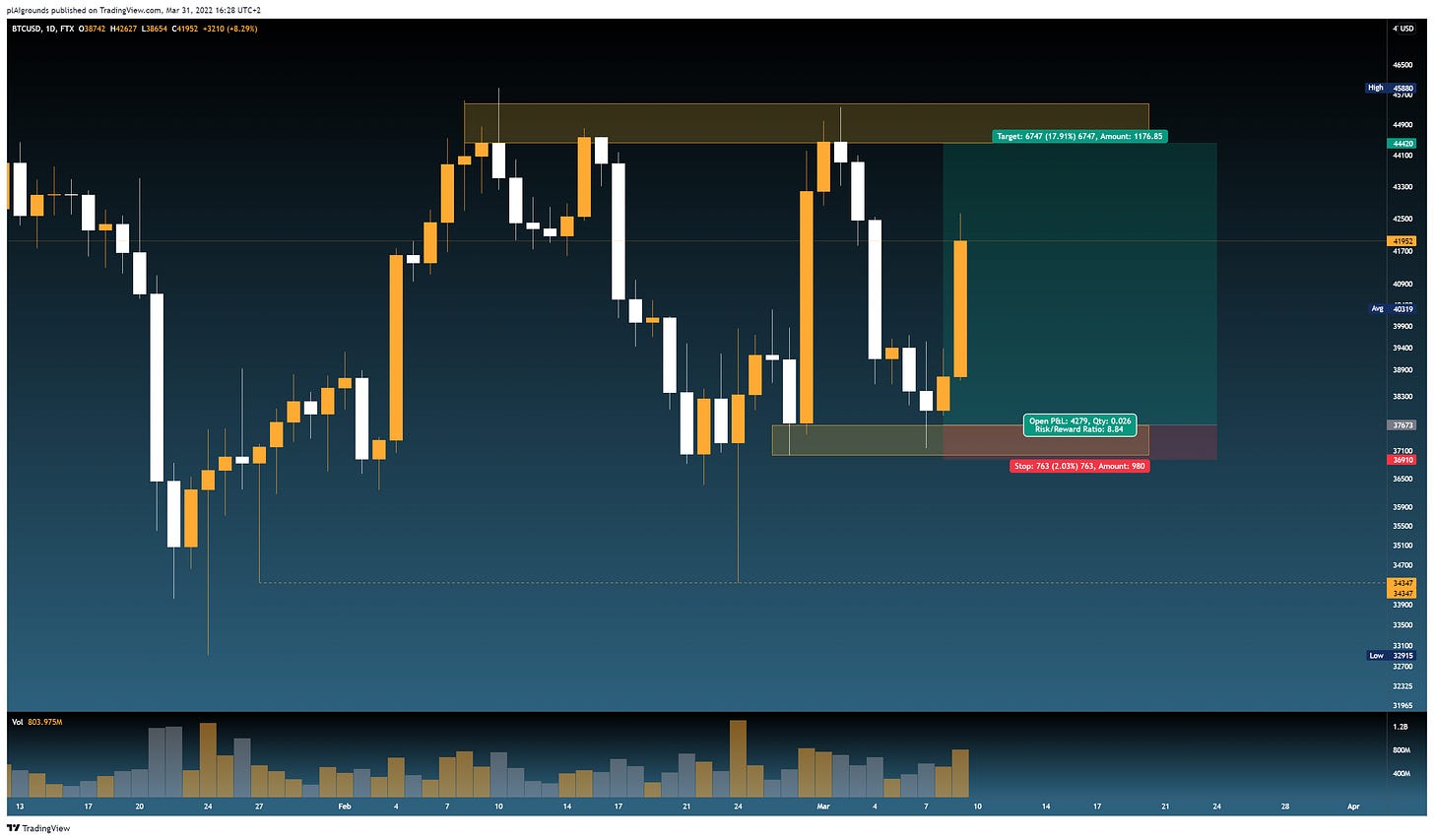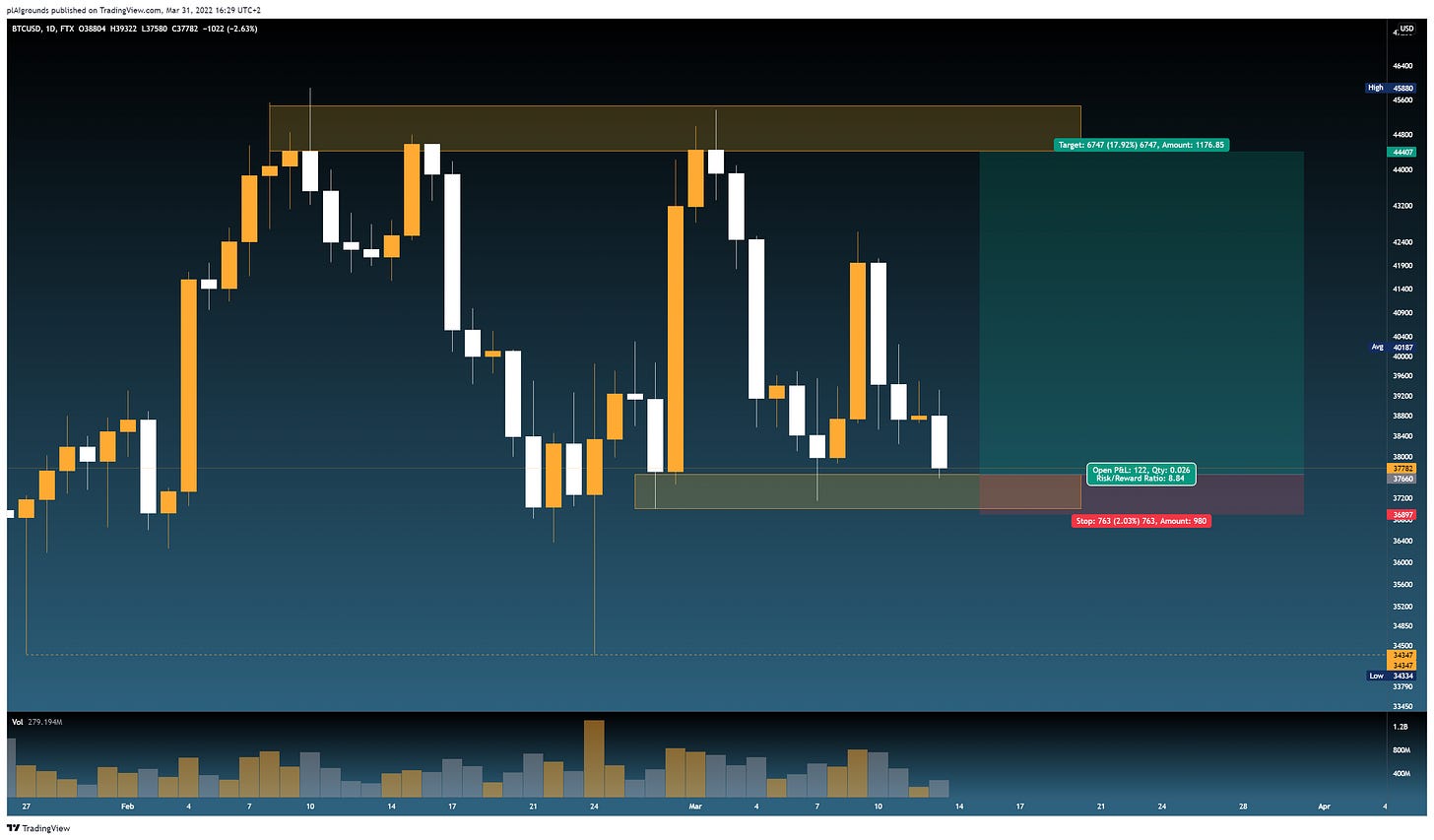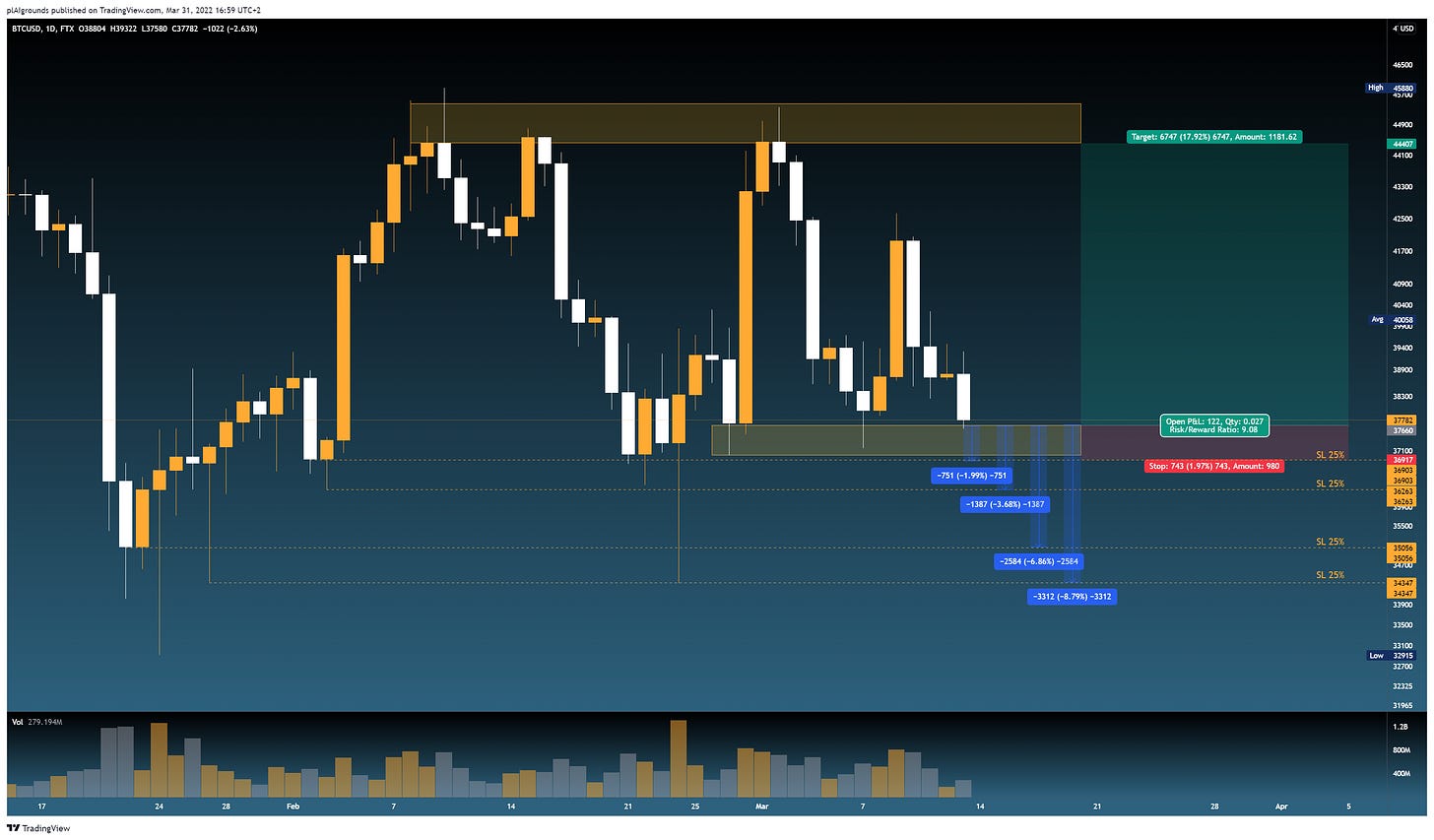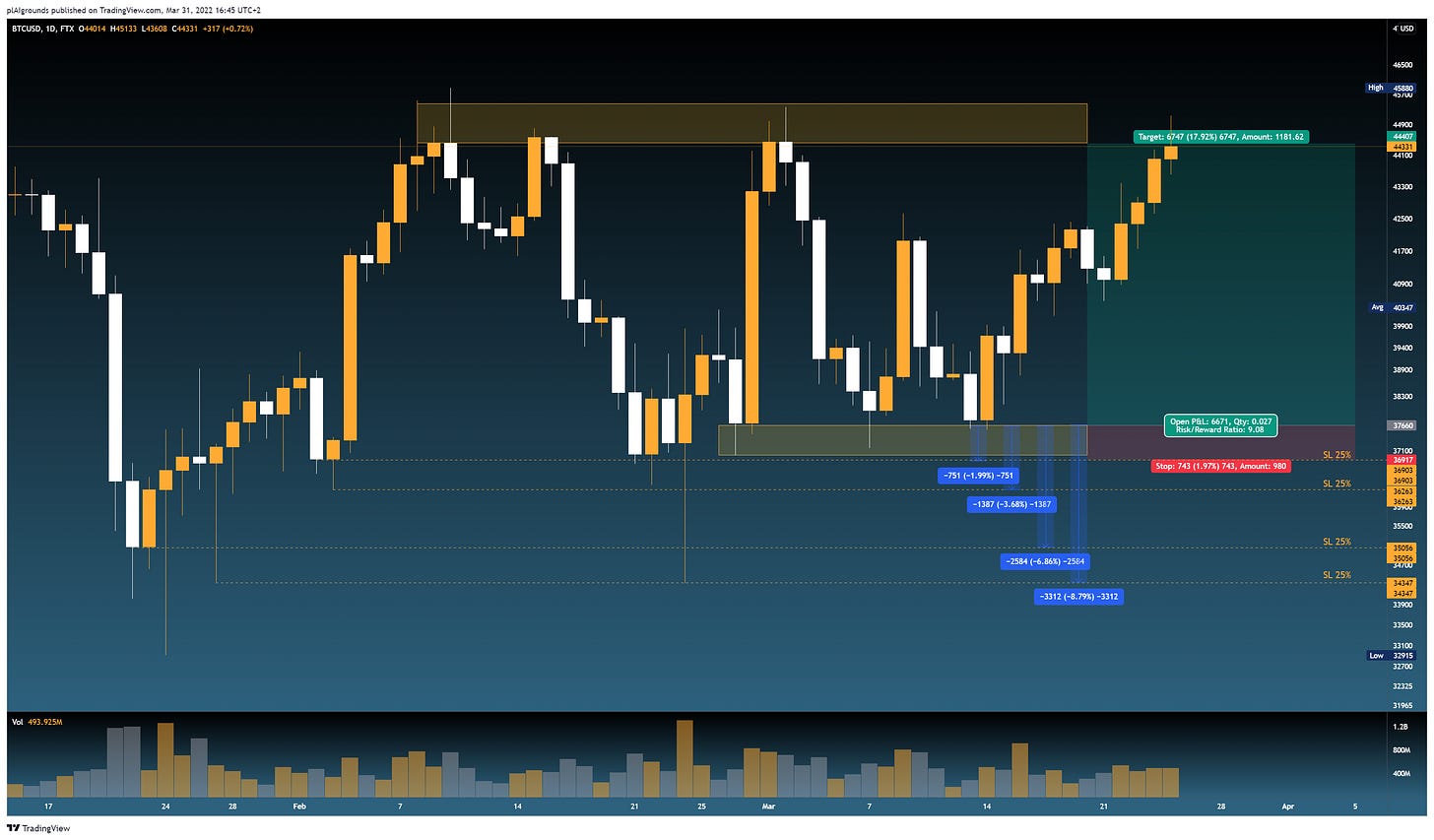Scaling In and Out of a Trade
One of the most important concepts in trading is scaling into/out of trades. Here we discuss how to identify confirmation of a trade, building out a position and exiting properly.
We all know how to set limit orders, stop-losses, and take-profit orders, but the trick is not the “how” but the “where” and “for how much?" This post will dive into three major concepts of a trade: entry, exit, and stop loss. We need to know exactly when to enter the trade, how to build our position as the idea confirms, how to reduce risk via stop-loss order in case the trade goes south, and of course when and how often to take profits.
Much of this information is subjective, and there’s no one correct answer. Instead, we’ll focus on a simple idea: instead of putting 100% of our position into a single limit order, we will scale in to a trade as the pattern plays out, using a series of stop-loss orders to minimize the downside. As the trade develops, we will use a series of take-profit orders to ensure we lock in the profits as the trade plays out.
Note: None of this should be construed as financial advice on behalf of ArcTaurus. These are simply trading ideas and strategies.
In this post I am going to demonstrate a very legitimate trade that doesn’t quite play out the way one might expect. This is a great example of adapting to a trade as it plays out. This post will be full of charts and examples, so we apologize for the length. Let’s dive in…
Confirming the Trade
The first step here is to identify a trade opportunity. For example, let’s go back a few weeks to when BTC was ranging between 37-45k. In the chart below we see that BTC has been strongly rejected from the 45k level three times in the past month, and is currently retracing back down to the somewhat obvious liquidity zone around ~$37k:
The first step is identifying the trade idea: once BTC reaches this zone of demand, we hope to see a bounce and move again towards $45k. The entry ($37674) and target ($44420) is clear, the time frame (1-2 weeks) is clear, but what about the stop loss? You can see on the chart that there are numerous deep wicks that likely stopped out many a trader looking for a good long opportunity. Our trade idea is solid, the R:R is exceptional, but the obvious risk is getting stopped out.
Due to this very real risk, we can avoid getting our entire position stopped out by instead scaling into the trade, which is exactly what it sounds like. Let’s say our desired position size for this trade is 1.0 BTC, we can first place an order for 0.25 BTC - 25% of our total position size. We set our stop loss just below this zone of liquidity (at $36911), and see what happens. Our R:R hasn’t changed, but the gross amount of money we’re risking is reduced by 75%. Let’s see what happens next:
The next daily candle closes, and we see that our entry has been struck, but we’re looking at a pretty volatile trading day - our position almost got stopped out. It is at this point that we must decide whether to increase our position size, let it ride, or reduce/close the position. For the sake of this tutorial, we of course want to leave the trade open so we can see how it develops. However, due to recent volatility we won’t increase our position size, and will see how the trade develops.
Adapting to Changing Conditions
The next daily candle comes in, and we see that we may be on the verge of a reversal. However, the daily closed at a period of high timeframe resistance, so we may yet see a dip into the liquidity zone before resuming upwards. This is where we can set a second limit order to increase our position size. At this point we know that there is solid demand at the $37k level, so let’s increase our position size by another 0.25 BTC to reach a total of 0.5 BTC. We set the limit order for 0.25 BTC at around $37674 again with an identical stop loss as before, and see what happens:
At this point, BTC has made a major pump and our second order was not hit. We are now in about 11% profit from our original entry, but with a significantly lower position size than originally intended. This is not the time to market buy in further. As you can see on the chart, BTC is pushing up against some low timeframe resistance, and may retrace yet further. If it retraces, the next logical destination is roughly a -6% drop down to at least $39000, putting at risk a large portion of our gains.
However, we’re in 11% profits. Do we secure these profits, or do we let it ride? There are two scenarios:
BTC gets rejected here and heads back down towards our entry
BTC continues upwards towards the supply zone above
Because the last two pumps reached the supply zone above, and each dip resulted in a higher low, we decide to let this trade ride through to the target - it’s more likely to continue its upward trajectory than dip below our entry, in my opinion. Let’s see how this plays out:
Redefining Risk
As you can see, I was wrong - we’ve fully retraced back to our entry and need to decide if we want to exit the position. However, this trade setup is still valid! We’re still making higher lows, above a high demand area, and our stop loss is still set.
Assuming we didn’t cancel the previous limit order to increase our position size1, we now have a position of 0.5 BTC at this level, with a very tight stop loss on both orders. It is here, then, that we can start to stagger our stop-loss orders to reduce our position size as the trade gets invalidated, while still keeping the position open in case it resumes its upward trend.
How one staggers the stop loss is up to the trader, but for the sake of simplicity I will divide it into 4 equal parts, each closing 25% of the position as the stop loss is hit. I like to choose stop loss levels slightly below significant levels such as the daily close, or the bottom of a deep wick. How you decide is up to you, but it is often important to consider recent volatility levels before spacing your stop-losses apart. The more volatile the recent price action, the wider your staggered stops can be.
Let’s calculate our current overall risk exposure. Our current position size is 0.5 BTC, with four equally-sized staggered stops. We can essentially divide these into four equal positions of 0.125 BTC each (each a quarter of 0.5 BTC).
Position 1: 2% stop loss, position size 0.125, risk: 0.0025 BTC
Position 2: 3.68% stop loss, position size 0.125, risk: 0.0046 BTC
Position 3: 6.86% stop loss, position size 0.125, risk: 0.008575 BTC
Position 4: 8.79% stop loss, position size 0.125, risk: 0.011 BTC
Added together, we end up with 0.026675 BTC at risk of a total position size of 0.5 BTC, for a total cumulative risk exposure of roughly 5%. A bit high, but given the potential return (almost 18%) we’re looking at a R:R of 3.6, which isn’t a bad trade at all.
Let’s see how this trade develops:
At this point, our target has been hit and we close the trade for a cool 18% profit on a position size of 0.5 BTC, walking away with 0.59 BTC (before fees). Not a bad trade after all, given the uncertainty along the way. We never reached our desired position size of 1.0 BTC, but given the circumstances this is still a very clear win.
Not all trades will go like this, however. The purpose of this example was to show how a position can be built and managed over time without exposing ourselves to too much risk.
Automating your Trades
Micromanaging trades like this can be time-consuming and exhausting. What if you could automate this entire strategy? With ArcTaurus, you can automate this entire trade setup without any programming knowledge! Our no-code platform allows you to automate complex trading strategies into easily-understandable logic blocks. Our next blog post will outline the steps to recreate this trade, automating the entire trade setup in just a few logic blocks.
Check out our addendum post here to learn how to build a bot to execute this trade.
If you have any questions, feel free to pop into our Discord server to ask either the community or ArcTaurus team for advice. You can also the rest of our links here, or send us an email at info@arctaurus.com.
It is not always a good idea to leave such an order open for long periods of time, as the context of the trade can change rapidly. For the sake of this example, we have left the limit order open as we still feel like it is a bullish setup based on the information available to us at the time.


